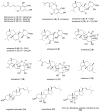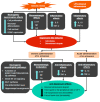Therapeutic Potential of Hericium erinaceus for Depressive Disorder
- PMID: 31881712
- PMCID: PMC6982118
- DOI: 10.3390/ijms21010163
Therapeutic Potential of Hericium erinaceus for Depressive Disorder
Abstract
Depression is a common and severe neuropsychiatric disorder that is one of the leading causes of global disease burden. Although various anti-depressants are currently available, their efficacies are barely adequate and many have side effects. Hericium erinaceus, also known as Lion's mane mushroom, has been shown to have various health benefits, including antioxidative, antidiabetic, anticancer, anti-inflammatory, antimicrobial, antihyperglycemic, and hypolipidemic effects. It has been used to treat cognitive impairment, Parkinson's disease, and Alzheimer's disease. Bioactive compounds extracted from the mycelia and fruiting bodies of H. erinaceus have been found to promote the expression of neurotrophic factors that are associated with cell proliferation such as nerve growth factors. Although antidepressant effects of H. erinaceus have not been validated and compared to the conventional antidepressants, based on the neurotrophic and neurogenic pathophysiology of depression, H. erinaceus may be a potential alternative medicine for the treatment of depression. This article critically reviews the current literature on the potential benefits of H. erinaceus as a treatment for depressive disorder as well as its mechanisms underlying the antidepressant-like activities.
Keywords: Hericium erinaceus; Lion’s mane mushroom; antidepressant; depression; mood disorders.
Conflict of interest statement
All authors declare no conflict of interest.
Figures




Similar articles
-
Two New Cyathane Diterpenoids from Mycelial Cultures of the Medicinal Mushroom Hericium erinaceus and the Rare Species, Hericium flagellum.Int J Mol Sci. 2018 Mar 6;19(3):740. doi: 10.3390/ijms19030740. Int J Mol Sci. 2018. PMID: 29509661 Free PMC article.
-
Hericium erinaceus: an edible mushroom with medicinal values.J Complement Integr Med. 2013 May 24;10:/j/jcim.2013.10.issue-1/jcim-2013-0001/jcim-2013-0001.xml. doi: 10.1515/jcim-2013-0001. J Complement Integr Med. 2013. PMID: 23735479 Review.
-
Chemistry, Nutrition, and Health-Promoting Properties of Hericium erinaceus (Lion's Mane) Mushroom Fruiting Bodies and Mycelia and Their Bioactive Compounds.J Agric Food Chem. 2015 Aug 19;63(32):7108-23. doi: 10.1021/acs.jafc.5b02914. Epub 2015 Aug 5. J Agric Food Chem. 2015. PMID: 26244378 Review.
-
Lion's Mane Medicinal Mushroom, Hericium erinaceus (Agaricomycetes), Modulates Purinoceptor-Coupled Calcium Signaling and Murine Nociceptive Behavior.Int J Med Mushrooms. 2017;19(6):499-507. doi: 10.1615/IntJMedMushrooms.v19.i6.20. Int J Med Mushrooms. 2017. PMID: 29199560
-
Anti-Gastric Ulcer Activity of Polysaccharide Fraction Isolated from Mycelium Culture of Lion's Mane Medicinal Mushroom, Hericium erinaceus (Higher Basidiomycetes).Int J Med Mushrooms. 2015;17(11):1055-60. doi: 10.1615/intjmedmushrooms.v17.i11.50. Int J Med Mushrooms. 2015. PMID: 26853960
Cited by
-
The Virus and the Famous: Narratives of Religious Experience by Selected Filipino Celebrities Who had COVID-19.J Relig Health. 2023 Apr;62(2):1394-1430. doi: 10.1007/s10943-022-01735-x. Epub 2023 Jan 30. J Relig Health. 2023. PMID: 36715877 Free PMC article.
-
Hericium erinaceus, a medicinal fungus with a centuries-old history: Evidence in gastrointestinal diseases.World J Gastroenterol. 2023 May 28;29(20):3048-3065. doi: 10.3748/wjg.v29.i20.3048. World J Gastroenterol. 2023. PMID: 37346156 Free PMC article. Review.
-
Influence of Short-Term Consumption of Hericium erinaceus on Serum Biochemical Markers and the Changes of the Gut Microbiota: A Pilot Study.Nutrients. 2021 Mar 21;13(3):1008. doi: 10.3390/nu13031008. Nutrients. 2021. PMID: 33800983 Free PMC article.
-
Neurotrophic and Neuroprotective Effects of Hericium erinaceus.Int J Mol Sci. 2023 Nov 3;24(21):15960. doi: 10.3390/ijms242115960. Int J Mol Sci. 2023. PMID: 37958943 Free PMC article. Review.
-
Antioxidants, Hormetic Nutrition, and Autism.Curr Neuropharmacol. 2024;22(7):1156-1168. doi: 10.2174/1570159X21666230817085811. Curr Neuropharmacol. 2024. PMID: 37592816 Free PMC article. Review.
References
-
- World Health Organization Depression 2018. [(accessed on 10 July 2019)]; Available online: https://www.who.int/news-room/fact-sheets/detail/depression.
-
- McMahon F.J., Buervenich S., Charney D., Lipsky R., Rush A.J., Wilson A.F., Sorant A.J.M., Papanicolaou G.J., Laje G., Fava M., et al. Variation in the gene encoding the serotonin 2A receptor is associated with outcome of antidepressant treatment. Am. J. Hum. Genet. 2006;78:804–814. doi: 10.1086/503820. - DOI - PMC - PubMed
Publication types
MeSH terms
Substances
Grants and funding
LinkOut - more resources
Full Text Sources
Other Literature Sources

